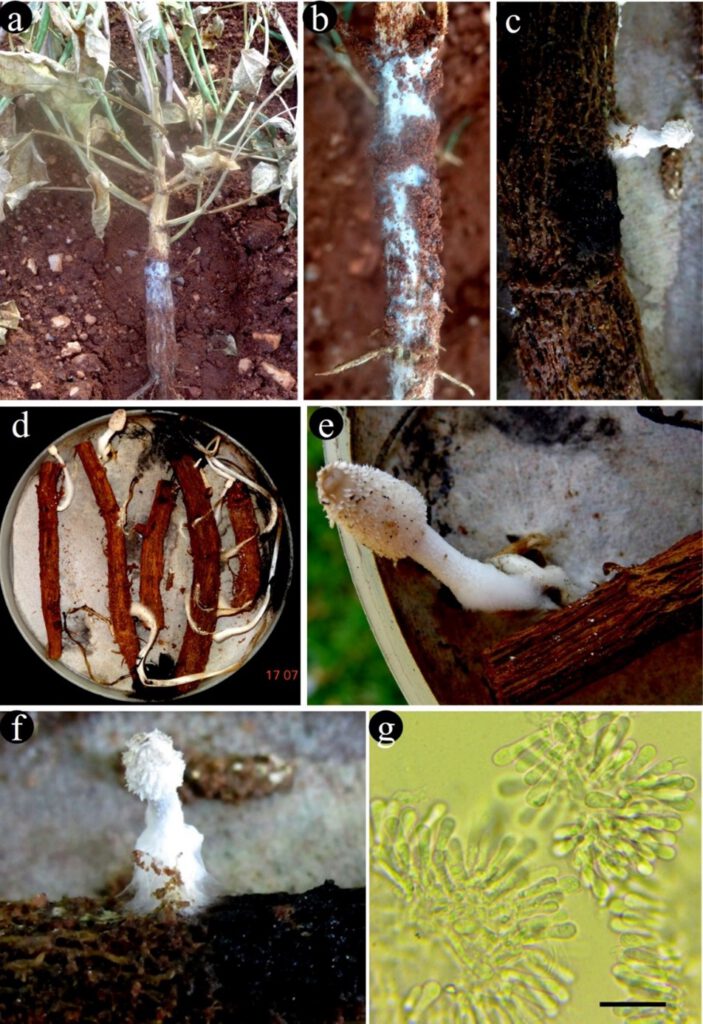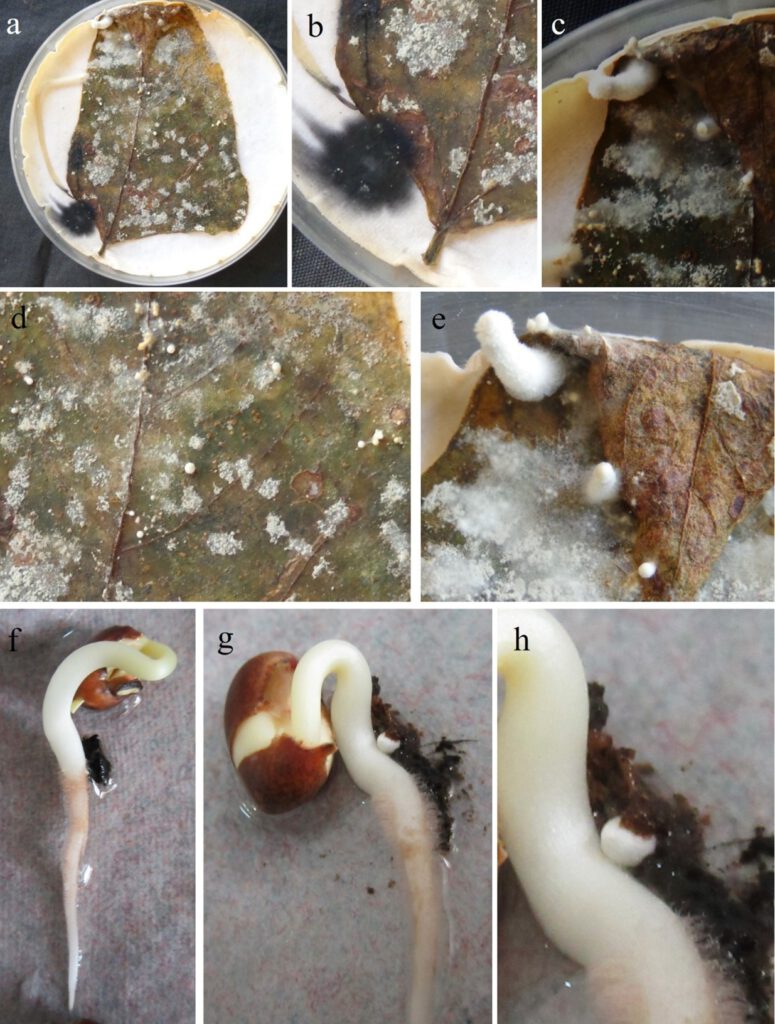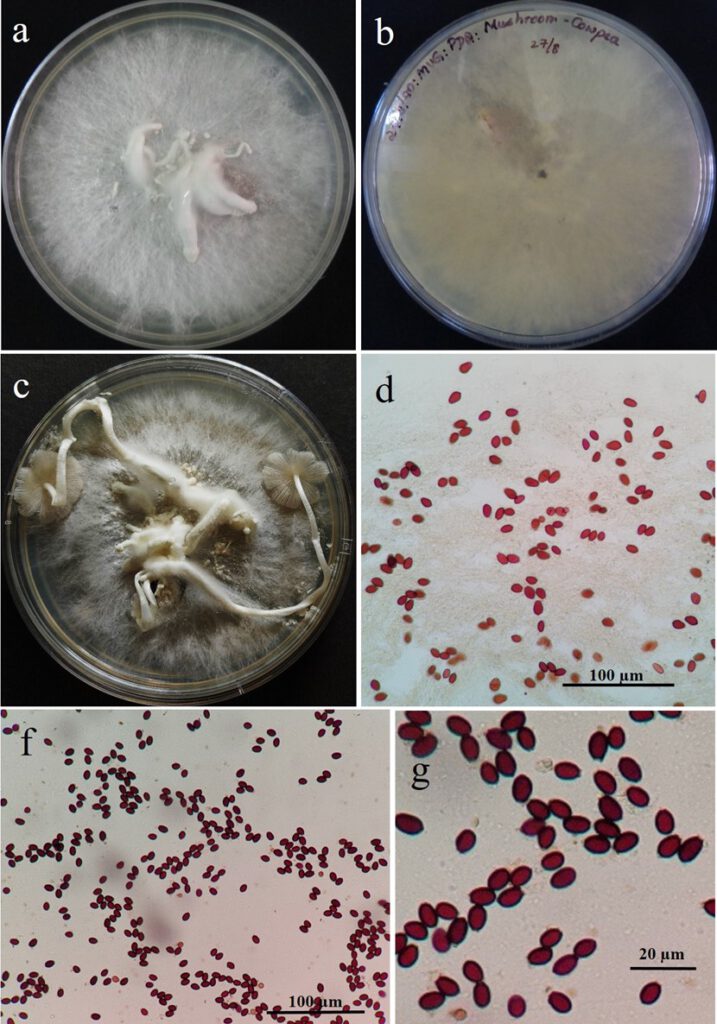Coprinopsis cinerea (Schaeff.) Redhead, Vilgalys & Moncalvo, in Redhead et al., Taxon 50 (1): 227 (2001)
MycoBank number: MB 474379; Index Fungorum number: IF 474379; Faceoffungi number: FoF 11681; Fig ****
Saprobic on roots of Vigna unguiculata. Sexual morph: Basidiomycetous. Basidiocarp 0.3–4 cm long, formed on the roots of cowpea, mycelial strands encircled the host tissues on the root region, and basidiocarp emerged upon incubation in moist chamber. Pileus strongly convex, and/or parasol-shaped to flat or depressed, hymenium borne on gills, becoming deliquescent and inky, lamellae thin, basidia unmodified, basidiospores 7.5–12.2×5−10 μm diam., ballistosporic, blue-black, smooth with a distinct germ pore. Asexual morph: undetermined.
Cultural characteristics: On PDA medium, colony were white and free from fruiting bodies till 5 days but later, development of basidiocarp was noticed which later enlarged and produced typical fruiting body. Upon examination of the basidiocarp from the PDA plates, microscopic examination of basidiospores revealed that they were same in morphological features.
Material examined: India, Karnataka, Mysore, Doddamaragowdanahally, on infected leaves of Vigna unguiculata (L.) Walp. (Fabaceae) placed on PDA as secondary saprophytes, 18 May 2017 Mahadevakumar (UOM-IOE-18/24), living culture (MD8).
Habitat: commonly found on dung or wood chips (Kamada 2002), roots and leaves of Vigna unguiculate (This study)
Distribution: worldwide
GenBank number: OM812073(ITS)
Notes: Coprinopsis species are known to grow on various substrates as secondary saprophytes and are also known to occur as primary components of soil and leaf litter. However, an association of Coprinopsis species has not been reported on any crop plants. Cowpea plants affected with a characteristic white cottony mycelium profusely grown on roots were observed which were eventually wilted and dried off which caused the death of the host plants. Infected materials were collected and subjected to pathogen isolation. Few infected parts were incubated at room temperature and observed for mycelial development. To our surprise, a characteristic mushroom fruiting bodies were developed. Therefore, the spores were photographed and subjected for identification. Here, the mushrooms are developed in three parts. Infected roots collected from the field, root samples incubated at room temperature and leaves incubated in a moist chamber (in a Petri plate) showed the development of small basidiocarp. Upon microscopic examination, it was identified as Coprinopsis sp. based on fruiting bodies, basidia, basidiospores, sterigmata and other associated structures. This is the first time that C. cinerea is reported from Fabaceae, Vigna unguiculata representing a new host record.

Fig. * Coprinopsis cinerea associated with root rot of cowpea: A Cowpea root showing fungal mycelium. B Close view of root showing white mycelium. C Root sample incubated at room temperature showing the formation of young basidiocarp. D Root samples showing emergence of basidiocarps on incubation at room temperature. E-F Close view of basidiocarp showing characteristic feature of Coprinopsis cinerea. G Basidium of Coprinopsis cinerea recorded. Scale bar: g=20µm.

Fig. * Coprinopsis cinerea developed on cowpea leaves: A – E Cowpea leaves showing the mycelial cords and development of basidiomata upon incubation at room temperature. F–H Mycelium colonizing the young root system under in-vitro condition.

Fig. ** Micro-morphology of basidiospores of Coprinopsis cinerea associated with root rot of cowpea: A-C Pure cultures of Coprinopsis cinerea established on PDA medium. D-F Microscopic view of basidiospores of Coprinopsis cinerea.
